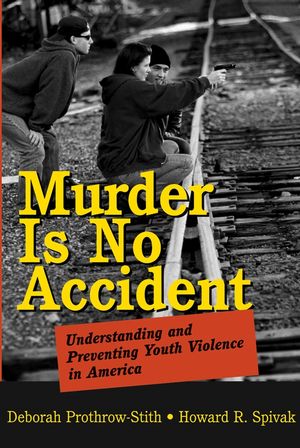Murder Is No Accident: Understanding and Preventing Youth Violence in AmericaISBN: 978-0-7879-6980-6
Hardcover
288 pages
October 2003, Jossey-Bass
 This is a Print-on-Demand title. It will be printed specifically to fill your order. Please allow an additional 10-15 days delivery time. The book is not returnable.
|
||||||
Prothrow-Stith, a Harvard School of Public Health associate dean
and professor, and Spivak, New England Medical Center's chief of
general pediatrics and adolescent medicine, bring impressive
credentials and two decades each of experience in medicine, public
health and violence prevention to this essential primer on
adolescent violence. In impassioned, colloquial prose, the authors
delineate the causes of teen violence (e.g., easy access to
weapons; violent entertainment); elucidate past approaches,
including police intervention for urban youth and mental health
intervention for suburban youth; explain the impact of racism and
classism on teen violence; offer first-person testimonies as
exhortations; and detail ploys to combat the problem before it hits
any more crisis points like the Columbine disaster or Los Angeles's
street gang wars. The authors also reveal their backgrounds in
order to break down stereotypes about violence: Prothrow-Stith's
African-American family was close-knit and nurturing. Spivak's
Bronx Jewish family excessively violent. But there's no discussion
of the trend toward prosecuting teens as adults or of the fact that
the U. S. remains one of only three nations worldwide to execute
teens. The nexus of the authors' argument: violence is pr4ventable,
but id does "take a village." Demonizing youth, treating teens of
color differently from white teens and focusing on crisis
intervention rather than preventives are mistakes that have
intensified rather than precluded violence, they say, insisting on
recognition of violence as a public health issue. This is a solid
and heartfelt contribution to a major concern in our country.
Agent, Kristen Wainwright. (Nov.)
Forecast: Blurbs from Sen. Ted Kennedy and Marian Wright
Edelman bespeak support for Prothrow-Stith and Spivak's approach.
Prothrow-Stith has discussed teen violence in many public forums,
including Nightline and Oprah. (Publishers Weekly, September
8, 2003)
Prothrow-Stith (public health practice, Harvard Sch. of Public Health) and Spivak (pediatrics & community health, Tufts Univ. Sch. of Medicine) begin with the premise that violence is not inevitable. They describe "a world gone mad" where murder and violent death are common aspects of children's lives, citing a recent study of 26 industrialized nations by the Centers for Disease Control and Prevention indicating that about 73 percent of all child homicides occur in the United States. Why? Several risk factors are delineated: poverty, alcohol use, guns, media, and witnessing violence. The authors point to the great success of Boston officials in decreasing juvenile murder rates over the last 20 years; also offered are compelling arguments against zero-tolerance policies, TV violence as entertainment, and demonizing young black men. No single explanation as to why the "Boston Model" works as well as it does is given, implying that dealing with youth violence requires sensitivity of thought. A concluding chapter summarizes lessons learned, e.g., that forgiveness is a strategy. An excellent addition to public libraries, this work is far more comprehensive than Betsy McAlister Groves's Children Who See Too Much, which describes Boston's Child Witness to Violence Project. —Linda Beck, Indian Valley Pl., Telford, PA (Library Journal, November 15, 2003)
"A clear, compelling, and much-needed examination of what causes youth violence in small towns and big cities all over America, and how one community was able to bring many partners and pieces of a complex puzzle together to curb youth violence in its neighborhoods. This book is an important reminder that youth violence is preventable. It should be read by every elected official, public health professional, community leader, advocate, and parent ready to move beyond despair or fear and take action."— Marian Wright Edelman, president, Children's Defense Fund
"Essential reading for public officials, concerned parents, and
citizens."
— Senator Edward M. Kennedy
"An eye-opening and well-documented book by two of the foremost
pioneers in violence prevention efforts in America. Through their
own personal stories and an astute analysis of the complexities of
violence prevention initiatives, the authors argue that violence is
learned behavior that can be significantly reduced. This is an
inspiring book; I highly recommend it."
— Alvin F. Poussaint, M.D., professor of psychiatry, Harvard
Medical School and Judge Baker Children's Center, Boston,
Massachusetts



